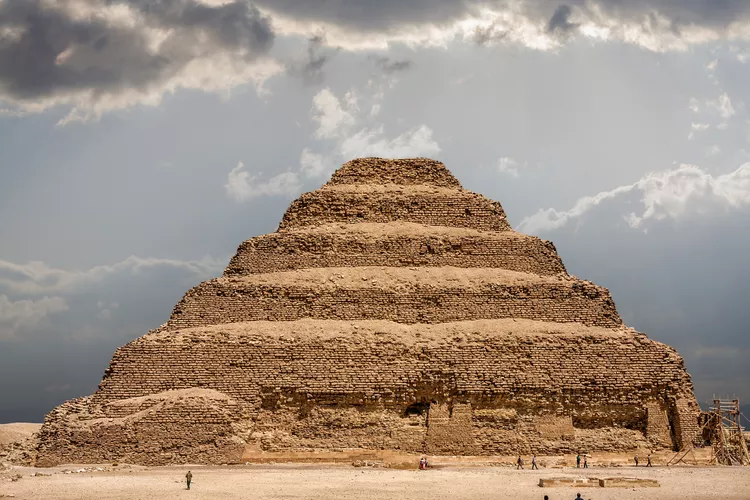Summary
History of the Site
Drive approximately 17 miles (27 kilometers) south of downtown Cairo and you’ll find yourself in Saqqara, the vast necropolis of the Ancient Egyptian capital of Memphis. Named for the Memphite god of the dead, Sokar, this is Egypt’s largest archaeological site. Although its pyramids may not be as famous as those located in nearby Giza, some, particularly the iconic Pyramid of Djoser, are considerably older. For archaeology enthusiasts, these groundbreaking structures are among the country’s must-see ancient sights.
The custom of burying pharaohs at Saqqara dates back thousands of years to the time of the First Dynasty, when kings ruled over a united Egypt for the first time. No fewer than 17 pharaohs are known to have chosen Saqqara as their final resting place, and royals, their family members, sacred animals, and important officials continued to be buried there for more than 3,000 years. Today, the Saqqara necropolis covers an area of 4 square miles (10 square kilometers).
As the burial site fell out of use during the Roman period, it was gradually reclaimed by the desert. Apart from the Pyramid of Djoser, the entire site was buried in sand by the time French Egyptologist Auguste Mariette uncovered the Serapeum in the mid-19th century. Since then, ongoing excavation, recovery, and restoration efforts have been underway at Saqqara. In 1979, it was inscribed as a UNESCO World Heritage Site alongside the pyramid fields that stretch from Giza to Dahshur.
One of the most recent discoveries occurred in July 2018, when archaeologists unearthed a mummification workshop that included five mummies and their jeweled sarcophagi.
The Pyramid of Djoser
The Pyramid of Djoser is without a doubt the most renowned landmark at Saqqara. Comprising six mastabas (flat-roofed tombs synonymous with the First and Second Dynasties) stacked in decreasing size, the pyramid has a unique stepped appearance. Dating back to the 27th century B.C., it was built as the burial complex for Third Dynasty pharaoh Djoser by his architect, Imhotep. This pyramid is the oldest known stone-cut monumental structure in the world, with Imhotep credited for laying the foundation for the later, smooth-sided pyramids.
Originally, the pyramid stood 203 feet (62 meters) tall, its sandstone slopes adorned with polished white limestone. While entry into the pyramid is now prohibited, the view from outside remains breathtakingly impressive.
Key Attractions
Many of Saqqara’s later pyramids were constructed during periods of economic hardship, resulting in the use of inferior materials that have not withstood the test of time. Ten pyramids remain besides Djoser’s masterpiece, some open for exploration. Notable among these is the Pyramid of Teti, a pharaoh of the Sixth Dynasty, whose inscribed basalt sarcophagus lies inside the burial chamber. Hieroglyphic spells from the Pyramid Texts adorn the interior walls.
Saqqara boasts an impressive array of tombs and mastabas in various states of preservation. The best among these include the Mastaba of Kagemni, Teti’s chief justice; and the Mastaba of Ti, the overseer of the pyramids at Abusir. The reliefs and friezes of the latter have been meticulously restored and are regarded as among the finest existing examples of Old Kingdom art, depicting scenes of daily life in Ancient Egypt accompanied by hieroglyphic dialogue.
The Serapeum, or underground burial chamber for the Apis bulls, is another highlight of the site. These sacred bulls, worshipped at the Temple of Ptah in Memphis during their lifetime, were mummified after death and interred in stone sarcophagi within the Serapeum, a practice that continued for over 1,300 years until ceasing in 30 B.C.
For those interested in learning more about the rituals of the Old Kingdom, a visit to the Imhotep Museum, located at the entrance to Saqqara, is highly recommended. The museum consists of five halls showcasing some of the site’s most significant finds, including the wooden coffin of Imhotep, the oldest complete royal mummy ever discovered, and a recreation of the library of French architect Jean-Philippe Lauer, who dedicated his life to excavating and restoring Saqqara’s treasures.
How to Get There
There are no public transport options from Cairo to Saqqara, so unless you plan to drive, a private taxi is your best choice for independent exploration. To avoid haggling over fares, ask your hotel to arrange a taxi for you. Given the vast size of the site, hiring a driver for the entire day is highly advisable, allowing them to transport you between Saqqara’s key landmarks.
Many travel agencies, hotels, and tour companies provide half or full-day tours to Saqqara. While group tours may limit your freedom to explore, they offer the benefit of inclusive costs and invaluable insights from professional Egyptologists. Many tours also encompass visits to nearby attractions, including Memphis and the Dahshur necropolis.
Things to Remember
Carefully timing your visit can significantly enhance your experience at Saqqara. The Egyptian workweek runs from Sunday to Thursday, and traffic congestion getting in and out of Cairo can be daunting on these days. To maximize your adventure, consider planning your visit for Friday or Saturday. Additionally, the time of day matters greatly, particularly during summer months; aim for an early visit to avoid the intense heat of midday.
Since there is little shade and no food or drink available at the necropolis, you will need to prepare accordingly. Bring essentials such as sunscreen, a hat, water, and perhaps a picnic. Comfortable walking shoes and a flashlight for illuminating the dim interiors of the tombs can also enhance your visit. Lastly, remember that Saqqara is extensive. Instead of attempting to see everything in one day, prioritize your must-see attractions to make the most out of your exploration.





